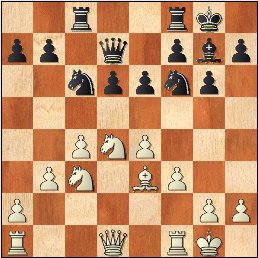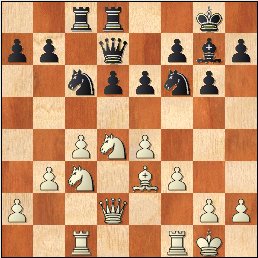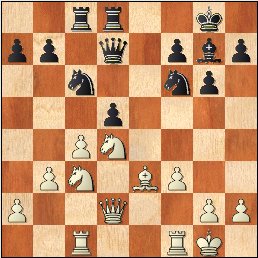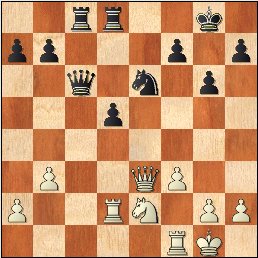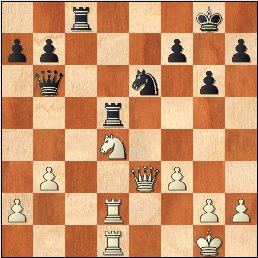All
the |
(Navigation bar
directly below.)
*******
© A.J. Goldsby, 2015.
(All rights reserved.)
****************
Click HERE
to see my
Chess Items.
****************
****************
Buy a book
from Amazon.com
(And help me out as well!)
****************
Click HERE
...
to see a list of the businesses that help to sponsor all of
my chess efforts.
Miniature
# 010
|
Click HERE to see an explanation of the symbols that I commonly use when I annotate any chess game.
Click HERE to replay this game ... on another server.
Vassily Ivanchuk
(2746) - Alexei Shirov
(2745)
|
|
|
[A.J. Goldsby I]
This year's winner ... ... ... plays last year's winner. (Who will come out on top?)
[As soon as I saw this KO on the Internet, I knew that I had to add it to my little collection of annotated games. How often does a Super-GM (2700+) lose a contest like this, especially with the White pieces?]
Note that all the moves in this game were checked with Fritz 11. (I also reviewed this game with Rybka, but I did not see any variations of any significance ... which merited their addition to this analysis. I also ran through this game with other programs, like Crafty, Junior 10.1, and Shredder. Once more, none of these analysis engines discovered anything new.)
1.e4 c5;
2.Nf3 d6;
So far, we have a Modern Sicilian.
3.Bb5+, (Moscow Variation)
This check, which at first glance looks to be completely harmless, has done in many strong players.
For a fairly detailed look at the theory of this system, please see my "Game of The
Month," for May,
2004.
(Or http://www.ajschess.com/thegotmman/gotm_may-04.html.)
[ Usually White will play the main line of the Open Sicilian with: 3.d4 cxd4; 4.Nxd4 Nf6; 5.Nc3, "+/=" etc. ]
3...Bd7;
This is the standard reply here.
[ Black can also play the Knight to the c6-square, but most players avoid this line, as it can lead to a bad set of doubled Pawns.
One sample continuation would be:
3...Nc6; 4.0-0 g6!?;
This could be a fairly dangerous attempt at counterplay by Black - but it seems to be the first choice of many players ...
especially if they have not studied the opening theory of this system.**********************************************************************************************************************************************************
**********************************************************************************************************************************************************(RR Probably safer is: >/= 4...Bd7; 5.Re1 Nf6; 6.c3, "+/="
when White's edge in space and development should be manageable.* * * * * * * *
After the moves: 4...e6; 5.Bxc6+!? bxc6, "~"
Black gets an ugly set of doubled QBP's that are not so easy to fix.
(I personally have played the Black side of this position in tournaments ... and lost with it.) )**********************************************************************************************************************************************************
**********************************************************************************************************************************************************5.d4! Qb6!?; (This is really dubious, the move of >/= 5...cxd4 had to be better.)
6.Nc3 Bd7; 7.dxc5! dxc5; 8.Nd5! Qd8; 9.Bf4, '±' and - in this position - White is clearly much better.IM Todor Todorov (2470) - FM Frederic Saez (2281); [B51] ICT, 2nd Grenoble / (R#8) / 26,06,2003. (1-0 in 23 moves.).
It is not recommended for Black to play his Knight to d7, as the second player can quickly get into a cramped position.
For example: 3...Nd7; ('!?') 4.0-0, This appears to be the most solid line for White.
**********************************************************************************************************************************************************
**********************************************************************************************************************************************************(One of the earliest known uses of this system is found in the following contest:
4.d4 cxd4; This is OK - and could transpose.(Perhaps a better line would be: 4...Ngf6; 5.Nc3 cxd4; 6.Qxd4 e5; 7.Qd3 h6; 8.Be3 Be7; 9.Bc4 a6; 10.a4, "+/="
and White is only slightly better.This is based on the contest: GM I. Glek - Voroblov; / Moscow, RUS; 2006.
[ See MCO-15, pg. # 355; column #06, and note # (x). ] ).
5.Qxd4 Ngf6; 6.Bg5, This is OK here ...
(Also good is: 6.Nc3, "+/=" (space) with the better game for White.)
6...Qa5+?!; (A mistake.) This is bad, better was 6...a6.
7.Nc3 a6; White is already clearly better. ("+/")
Now play becomes wild, with White eventually coming out on top.
8.b4!? Qd8; 9.Bxf6 gxf6; 10.Bxd7+ Bxd7; 11.Nd5 b5!?; 12.Nh4! Rc8; 13.Nf5! Bxf5; 14.exf5 Bg7?!;
15.0-0 0-0; 16.Rae1 Re8; 17.Re2 Rc6; 18.Rfe1 e5; 19.fxe6 fxe6; 20.Rxe6 Rxe6; 21.Rxe6 Rxc2;
22.Qe3! Kf8; 23.h4 h5; 24.Re7 Qc8; 25.Ra7, "+/-" and Black resigns. 1-0A. Lilienthal - A. Kotov; / 12th URS Champ. / Moscow, U.S.S.R; 1940.
(This is one of the earliest games ... between fairly strong players ... that I could discover in the DB.) ).**********************************************************************************************************************************************************
**********************************************************************************************************************************************************4...Ngf6; 5.Re1 a6; 6.Bf1 e6; 7.c3, "+/=" (space) and White is just a little better.
(The position is similar to a Ruy Lopez, except that White's Bishop is on f1 instead of b3.)There are a number of nice games by White in the database, you can simply take your pick. ]
4.Bxd7+,
This is the 'normal' move here.
[ An interesting alternative is: 4.Be2!?,
"+/=" when it usually transpires that White's Bishop is OK on its current square,
but
Black will want to move his cleric on d7 again ... as on its current square, it is simply in the way of most of Black's pieces.
]
4...Qxd7;
This is best, as Black's QN belongs on the c6-square here.
5.c4,
An attempt to grab space and also prevent Black from playing his freeing ...d6-d5 pawn break.
[ Black is also OK if White castles here. For example:
5.0-0 Nc6; 6.c3 Nf6; 7.Re1 e6; 8.d4 cxd4; 9.cxd4 d5!; 10.e5
Ne4; "="
with Black having suitable play.
M. Knezevic - R.J. Fischer; /
FIDE World Team Champ.
(This team tournament is more commonly known as "The Olympiad," {'Ol'}
and has traditionally been a biennial event.)
Skopje, YUG; (R#10) 1967. {Drawn in 47 total
moves.}
[ See MCO-15, pg. # 355; column # 05, and note # (t.). ] ]
5...Nf6; 6.Nc3 g6!;
This must be good, since Black already controls d4 and e5, this development of the Black Bishop only highlights the second player's control of the long diagonal.
****************************************************************************************************************************************************
Both players continue developing, all the while - marching down a "known <book line.>"
[I would consider the position after 12.b3, "+/=" to be the critical one ... for the assessment of this whole opening.]
7.d4 cxd4; 8.Nxd4 Bg7; 9.f3 0-0; 10.Be3 Nc6; 11.0-0 Rac8; 12.b3, "+/=" 12...e6; {See the diagram given - just below.}
|
|
2r2rk1/pp1q1pbp/2nppnp1/8/2PNP3/1PN1BP2/P5PP/R2Q1RK1 - White to move.
Thus far, both parties have developed in a logical manner, and White is probably just a little better in this position.
13.Rc1!?,
This is OK ... (and even good for White).
{And this move is also the #1 'book' move here.}
[ However, the play of: >/=
13.Ndb5!, "+/=" (hits d6 and a7)
might have been a little better. (It is up to Black to prove that
he can equalize after this fairly ambitious try by White.)
]
13...Rfd8; 14.Qd2, (14.Qe1!?)
White prepares to double his heavy pieces ... a seemingly logical approach.
(I am sure that if Ivanchuk had won this game, we would not be questioning nearly every one of his moves!)
{Again - this is a 'book' move.} {See the diagram given - just
below.}
|
|
2rr2k1/pp1q1pbp/2nppnp1/8/2PNP3/1PN1BP2/P2Q2PP/2R2RK1 - Black to move.
[ Also possible was: 14.Nxc6 Rxc6; 15.Qd3 a6; 16.Rfd1, "+/=" (space) with an edge for White. ]
14...d5!?; (Probably - '!')
Timing is everything in chess, if Black is going to play this move, it has to be now. (Of course - if Black had lost this game, then I would probably be adorning this move with a big, fat question mark.)
15.exd5 exd5; (Critical MG
position.) {See the diagram given -
just below.}
This position must be a critical one, for this game ... and this whole line.
|
|
2rr2k1/pp1q1pbp/2n2np1/3p4/2PN4/1PN1BP2/P2Q2PP/2R2RK1 - White to move.
I would say that Black has solved nearly all of his opening problems, and possibly even a quick draw could be the correct result of this particular position.
16.c5?!; (Maybe - '?')
This is the root of most of White's problems, nearly all of Ivanchuk's future difficulties can be traced directly back to this errant play.
(The WP turns out to be a target on the c5-square.) {Strangely enough - this move is also part of the Fritz "Power-Book" library.}
[ It was best to play: >/= 16.Nxc6 bxc6; 17.cxd5 Nxd5; 18.Nxd5 cxd5; 19.Bd4 a6; "=" when White should be OK. ]
16...Nxd4!;
A move that is NOT part of the "PB" ream of analysis. (The PB gives only 16...Re8 and 16...a6.)
However, this is not a new move ...
... as far as I can tell, it was first played in the following clash:
J. Bednarski - J. Pokojowczyk; /
ICT / Slupsk, POL; 1978. {Black won, 0-1 in 30 sharp moves.}
[ For the move of: (>/=) 16...Re8; please see the following contest:
GM Boris Gelfand (2675) - GM Alexei Shirov (2710); /
Hoogovens Blitz
Wijk aan Zee, (R#3) NED; 1998. {Drawn in 74 total moves.}
]
17.Bxd4 Ne4!;
This is - by far - the most forceful move, and Fritz readily confirms this.
(It also is NOT a new move either, it was first played in a German correspondence game in 1991!)
18.Qe3!?, (Maybe - '?!' or even '?')
I am not sure why Ivanchuk is keeping material on the board, (IMO) this can only lead to more problems for White.
The move 18.Qe3 is also NOT a new move, having been previously played in the aforementioned correspondence game.
See the contest: M. Schuetze - H. John; /
GER-ch23, sf4 corres. / Germany, 1991.
{Black won a relatively quick decision, 0-1 in 28 total moves.}
[From this point forward, I will no longer consult the games DB for previous examples, but will simply content myself with the pure analysis of the moves in this struggle.]
[ I think that it was better to play: (>/=)
18.fxe4 dxe4; 19.Nxe4 Qxd4+;
20.Qxd4 Bxd4+; 21.Kh1 b6; 22.cxb6 Rxc1; 23.Rxc1 Bxb6;
"=/+"
when Fritz shows that Black might be a little better here, however, I cannot really see Ivanchuk losing from this particular position.
]
And here Black wins a Pawn ...
18...Nxc5; 19.Rcd1,
Now it does not look good to take the QR off the c-file.
[ Maybe it would have been wiser to play the following continuation:
(>/=) RR 19.Rfd1 Bxd4; 20.Qxd4 Ne6;
21.Qxa7 d4; "/+"
when Black is better, but White's position is not entirely devoid of counterplay.
]
19...Bxd4; 20.Rxd4 Qc6;
21.Ne2!?, (hmmm)
White's position seems to get a little worse with every play.
[ Or 21.Rfd1 Re8; 22.Qf2 Ne6; "/+" and Black is clearly better. ]
21...Ne6; 22.Rd2!?, ('?!') {See the diagram given -
just below.}
Once more, White moves a piece backwards.
|
|
2rr2k1/pp3p1p/2q1n1p1/3p4/8/1P2QP2/P2RN1PP/5RK1 - Black to move.
Black is a Pawn up, but no clear win is in sight at this point.
[ Maybe (>/=) 22.Rd3!?, was a little better than what occurred in the actual game? ]
22...d4!;
This pawn charges forward and disrupts White's pieces.
(Of course, the Pawn is off limits, however, Ivanchuk does not readily divine this fact.)
23.Nxd4?, (Maybe just - '??')
Ivanchuk captures the offending foot soldier here. however, this move is a terrible mistake for White.
[ Instead, after the moves: >/=
23.Qe4 Qb6; 24.Kh1 Nc5; 25.Qg4 h5; 26.Qg3 d3;
"/+" ("-/+")
Black is a Pawn up with a dominating position
... however, White could play on - if he was so inclined.
]
23...Qb6!; 24.Rfd1 Rd5!; "-/+" {See the diagram given - just below.}
|
|
2r3k1/pp3p1p/1q2n1p1/3r4/3N4/1P2QP2/P2R2PP/3R2K1 - White to move.
White resigns, his position is hopeless. A big part of White's problem is the pin on the a7-g1 diagonal ... ... ...
A marvelous game by Shirov, but this was obviously not one of Ivanchuk's best efforts! (I am a big fan of both GM's here. I celebrate Shirov's success in this struggle, but I regret the fact Ivanchuk was in poor form.)
I also do not wish to make excuses for any player, yet it is possible that this loss by GM V. Ivanchuk - at least in part - might have been caused by an over-reliance on the
computer's book.
***************************************************************************************************
------> I also wish to note that GM
Alexei Shirov went on to win this tournament, (Ivanchuk won
last
year! more); ...
... ...
obviously -- a move to save White's Knight ... like Ne2 -- will simply drop the WQ on the e3-square. (Black can simply double his Rooks on the d-file and win White's Knight.
And after 25.Nc2, Rxd2; 26.Rxd2, Rxc2!; 27.QxQ/b6, Rc1+; and 28...a7xQ/b6; Black {again} will come out a piece up. Another try for White is 25.Kf2, to try and protect the WQ. However Black simply continues with 25...Rcd8. Now if White tries to save his Knight {Ne2}, he loses a Rook on the d2-square ... the WQ cannot recapture, as it would be pinned to the WK.)
for more details, please see the official
website. (http://www.mtelmasters.com/en/)
For the ChessBase report on the first round of this tournament, please see the
link: http://www.chessbase.com/newsdetail.asp?newsid=5427.
(For the CB report on the whole of this event, see the link: http://www.chessbase.com/newsdetail.asp?newsid=5457.)
Copyright (c) A.J. Goldsby, 2009. All rights reserved.
0 - 1
-
I have tried to link all the games {given/mentioned on this page} to the "Chessgames" website. However, if you cannot find any game (there), then please go here.
My oldest daughter, Ailene Goldsby, (in the past) had picked out the designs, colors and backgrounds for many of my web pages.
This
time, my youngest daughter, Angel Goldsby, wanted a turn. So she picked out the
background and colors for this web page.
("Daddy and I made the best possible web page. I hope you like
it." - Angel Goldsby)
-----> This game was prepared and annotated using the program, ChessBase 10 ... and also the analysis engine of Fritz 11. (The ChessBase website.)
A chess blog ... that discusses this game and this page.
Click HERE to - go to or return - to my HOME PAGE ... for this site.
Click HERE to go (or return) to my site map (page).
Click HERE to go to my "Annotated Games II" (page).
Click HERE to go (or return) to my {2nd} main page on miniatures / or "Best Short Games," (Vol. IV.)
(Or you could use the "Back Button" on your web browser.)
Copyright (c) LM A.J. Goldsby I
***************
Copyright (©) A.J. Goldsby, 2012. All rights reserved.
***************
I first began annotating this game in May, 2009. This page was created in late June, 2009. It was posted on: Tuesday / July 21st, 2009. It was last updated on: December 02, 2012 12:05 AM .
